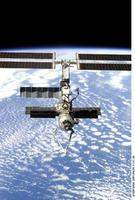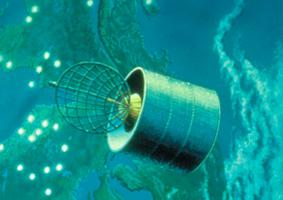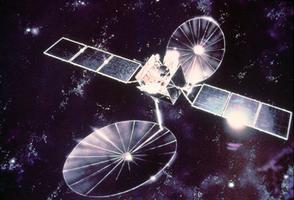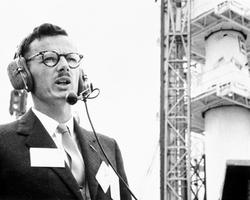Space Technology
Canada's entry into the Space Age was prompted by an interest, which increased markedly during WWII, in the investigation of the properties of Earth's upper atmosphere and, in particular, the ionosphere - the layer of charged particles which reflects shortwave radio signals.
Satellites
An agreement signed with the US National Aeronautics and Space Administration (NASA) led to the launching of a series of 4 Canadian satellites, beginning with Alouette 1 (on 29 Sept 1962) from the Western Test Range in Vandenburg, California.
Alouette 1 carried 2 Canadian-developed spacecraft antennae with tip-to-tip lengths of 23 and 45 m, respectively, which were deployed after the satellite was in orbit. Alouette 1 was followed by Alouette 2 (1965) and by ISIS (International Satellites for Ionospheric Studies) 1 (1969) and 2 (1971).
These satellites were designed and built at the Defence Research Telecommunications Establishment in Ottawa (in 1969 this became the Communications Research Centre (CRC) of the Dept of Communications). Each satellite was increasingly complex in design and measurement capability and each involved greater participation by the then developing Canadian aerospace industry.
Other Canadian and foreign organizations contributed equipment and experiments to the program, and studies were carried out using the results from the satellite investigations in conjunction with ground-based measurements in various countries.
Alouette 1 and ISIS 2 were launched into near-circular orbits, at about 1000 km and 1400 km above Earth respectively; Alouette 2 and ISIS 1 were launched into elliptical orbits with perigees of 500 km and apogees of 3000 and 3500 km respectively. Each of the Alouette/ISIS series of satellites vastly exceeded its design lifetime.
Telesat Canada Corp
Canada's attention then turned to applying space technology to serve the requirements imposed by the country's widely dispersed population, its vast distances, diverse terrain and severe climate. In 1964 Canada joined with several other nations in establishing an international system (Intelsat) for the exchange of commercial international telecommunications traffic.
Following a 1968 white paper on the possibility of establishing a domestic satellite communications system, the Telesat Canada Corp was established by an act of parliament in 1969. The corporation was initially owned jointly by the federal government and Canadian telecommunications carriers; the Canadian government sold its shares in 1992. Telesat's monopoly on satellite communications to and from points in Canada expired on 1 March 2000.
Anik A Series
With the launch of the first of Telesat's 3 Anik A satellites in late 1972, Canada became the first country to implement a commercial domestic satellite system operating in geostationary orbit (35 790 km above the equator). The satellites were stabilized in orbit by the technique known as spin-stabilization, in which the communications antenna and associated platform are de-spun so that the antenna points continually toward Earth.
This series was built by a US prime contractor but involved major participation by Canadian industry. These satellites operated in the 6/4 GHz band (transmitted at frequencies of 4 GHz (billion hertz) and received at 6 GHz) and were located at 104°W, 109°W and 114°W longitude.
Hermes
In 1971 Canada entered into an agreement with NASA for the development and launch of an experimental Communications Technology Satellite (CTS). CTS, known as Hermes in Canada, was launched on 17 Jan 1976.
Hermes had several objectives: to develop and flight-test a high-power, high-efficiency travelling-wave-tube amplifier (wide band power amplifier such as those used in radar or communications transmitters) operating at 12 GHz; to develop and flight-test a 3-axis stabilization system to maintain accurate antenna pointing; and to conduct communications experiments in the newly allocated 14/12 GHz frequency bands using small, transportable Earth stations.
The satellite was designed and built in Canada at the CRC by a joint government and industry team of scientists and engineers. Use of the satellite permitted investigation of a number of innovative approaches to the delivery of new communications services and extension of existing services to remote and rural regions.
Hermes was the first satellite capable of broadcasting television and radio programs directly to inexpensive home receivers and was equipped with spot-beam antennae which could be directed to any point on Earth that was visible from the satellite. Hermes was built to last 2 years but operated for nearly 4.
Space Environmental Test Facilities
To test various subsystems of the satellite in a simulated space environment, the federal government established the satellite assembly, integration and test facilities of the David Florida Laboratory at CRC, now part of the Canadian Space Agency. These were later expanded to permit testing of complete spacecraft of a shuttle class in the simulated thermal, vacuum, vibration and electromagnetic environment of space. Techniques for computer simulation and analysis of spacecraft motions were also developed.
Anik B
Because of the success of the Hermes program and under an arrangement between Telesat Canada and the federal government, the next satellite to be built for Telesat Canada, Anik B, was equipped with 4 experimental 14/12 GHz transponders in addition to 6/4 GHz transponders used by the earlier Anik A satellites.
A transponder is an electronic device which receives a signal and retransmits it at a different frequency. Anik B, when launched in late 1978, thus became the world's first satellite to operate simultaneously in both of these pairs of frequency bands. Anik B was somewhat higher powered than Anik A and was 3-axis stabilized to maintain a precisely controlled fixed orientation in space.
Anik D Series
Later the Anik D series replaced the capacity of the then failing Anik A and aging Anik B satellites. Anik D-1, launched in Aug 1982, was the first commercial satellite built by a Canadian prime contractor, Spar Aerospace Limited. Anik D- 2 was launched in Nov 1984.
Anik C Series
The first of the Anik C satellites, which operate in the higher 14/12 GHz bands, was 1 of 2 satellites which inaugurated the operational use of the US Space Shuttle in Nov 1982. The other satellites in the Anik C series were launched in June 1983 and Apr 1985.
Anik E Series
In 1987 Telesat Canada awarded a prime contract to Spar Aerospace for the provision of 2 Anik E satellites. The satellites which were deployed in 1991 have a number of transponders operating in both sets of frequency bands, replacing both the Anik C and Anik D satellites. Anik F1 and F2, under construction by Hughes Space and Communications Co, are scheduled to be launched beginning in 2000 and will provide two-way communications in the so-called Fixed Satellite Service, augmenting and replacing Telesat's earlier satellites. Telesat's newest satellite, Nimiq, was launched on 20 May 1999. The satellite will provide Canadians with direct-to-home television from its position in geostationary orbit at 91°W longitude.
Space Science
Space science activities previously coordinated by the Canada Centre for Space Science of the NRC are now the responsibility of the Canadian Space Agency. In a cooperative program with Sweden, Canada has provided ultraviolet imagers for the Swedish Viking satellite, launched in 1986 to obtain images of the Northern Lights, and for the Freja satellite launched in 1992. The Freja satellite also carried a Canadian-built instrument called the Cold Plasma Analyzer; the Swedish Olin satellite launched in 1997 carried a Canadian imaging spectograph called OSIRIS. In 1989 a Canadian instrument, the Suprathermal Ion Mass Spectrometer (SMS), was carried aboard the Japanese EXOS-D or Akebono satellite.
Canada provided the highly successful Wind Imaging Interferometer (WINDII) which was flown on NASA's Upper Atmospheric Research Satellite (UARS) in 1991. WINDII measures wind velocity and atmospheric temperatures to aid among other things in monitoring stratospheric ozone. Several Canadian scientific payloads are being carried on board flights of the US Space Shuttle and a Canadian-built Ultraviolet Auroral Imager is to be flown on the Russian Interball satellite.
Canada continues to launch various space science instruments using balloons, rockets and satellite platforms provided by other countries as vehicles, and conducts various life sciences experiments using the space shuttle and Russian space station MIR. An atmospheric chemistry experiment (ACE) proposed by the University of Waterloo has been chosen by the Canadian Space Agency as the first space science payload to fly on the purely Canadian SCISAT-1, scheduled for launch in 2001.
Manned Space Programs
Canadarm
In 1975 Canada signed an agreement with the US to participate in the Space Transportation System (shuttle) by providing a unique remote-manipulator system, later named the Canadarm, to be mounted on the space shuttle to move payloads in and out of the shuttle bay. This work was carried out by a Canadian industry team led by Spar Aerospace under contract to the National Research Council of Canada (NRC).
A general purpose simulation facility (called SIMFAC) was designed, using mathematical modelling techniques, to verify Canadarm's operability in a zero-gravity environment and to train astronauts to operate the Canadarm in space. While the arm cannot support its own weight on Earth, it is capable of manipulating a payload of nearly 30 000 kg in space, manoeuvring it at 6 cm/s and placing it in any position with an accuracy of about 5 cm.
The Canadarm was declared operational in Nov 1982 after having been flown successfully on the second, third and fourth shuttle launches, and having been used in manoeuvring and handling exercises. NASA procured 3 additional systems directly from Spar Aerospace. All have been deployed successfully on subsequent shuttle flights.
Mobile Servicing System
Canada is participating in the US Space Station Program through the provision of a Mobile Servicing System (MSS), a large robotic manipulator built by a consortium of companies led by Spar Aerospace. Canada's contribution includes the Space Shuttle Remote Manipulator System (SSRMS) and Mobile Base System (MBS) as well as the design of the Special Purpose Dextrous Manipulator (SPDM) to help assemble and maintain the space station.
Canadian Space Station Program
As part of the Canadian Space Station Program (CSSP), the government has been supporting a number of Canadian initiatives in the development of strategic technologies in automation and robotics and in the exploitation of the microgravity environment on the space station, particularly in the areas of materials science and biotechnology. Construction of the space station began in November 1998.
Canadian Space Agency
In the speech from the throne on 1 Oct 1986, the Canadian government announced its intention to create a Canadian Space Agency (CSA) to incorporate and coordinate many of the space activities previously carried out in various departments and agencies of the federal government. The Canadian Space Agency Act was passed by the House of Commons on 14 Dec 1989, and proclaimed a year later. The agency's objectives are to promote the peaceful use and development of space and to ensure that space science and technology provide social and economic benefits for Canadians.
The CSA is responsible for the Canadian astronaut program, which manages the selection, training and space flights of Canadian astronauts. Several Canadian astronauts have participated in space shuttle missions: Dr Marc Garneau (1984, 1996); Dr Roberta Bondar (1992); Dr Steve Maclean (1992); Col Chris Hadfield (1995, 1998); Dr Dave Williams (1995); and Julie Payette (1999), the first Canadian to participate in an international space station mission and the first to board the station.
According to "The State of the Canadian Space Sector 1997," published by the CSA, the Canadian space industry generated revenues over $1.25 billion in 1997 and employed over 5300 people. This represents increases of over 30% in total sector-wide revenues and close to 11% in total employment from 1996, when exports accounted for 31% of total revenues or $301.2 million.
In 1997, while total revenues increased by 30%, export revenue increased by over 88% to $566.4 million. This figure of 45% of total revenue is unmatched by any other country. Satellite telecommunications in Canada accounts for 69% ($861 million) of total space activity, with earth observation representing 14% ($177 million), and robotics 10% ($126 million).
See also John Herbert Chapman.
Search and Rescue
Another area in which Canadian space and related technology has pioneered is in the application of space techniques to assist in search and rescue. All aircraft in Canada are equipped with emergency locator transmitters (ELTs) which may be turned on manually or are activated automatically on impact.
SARSAT Project
A concept was developed to use satellites in low orbits highly inclined to the equator to detect aircraft and ships in distress. Canada joined with France and the US and several other countries to demonstrate the operational use of the concept through the SARSAT (Search and Rescue Satellite Aided Tracking) Project.
Canada supplied the satellite transponders operating at frequencies of 121.5, 243 and 406 MHz, and designed and built the ground station for reception of the satellite-relayed signals. France provided the on-board signal processor and the US contributed the spacecraft antennae and tested, integrated and launched the SARSAT space hardware on board the NOAA series of meteorological satellites. The first launch of a SARSAT-equipped spacecraft was in Mar 1983; a number have been launched since.
COSPAS-SARSAT Network
To allow more frequent coverage of Earth's surface, an arrangement was concluded with the former Soviet Union for the launch of a compatible system, called COSPAS. The first satellite equipped with the COSPAS system was launched in June 1982.
In 1984 a memorandum of understanding was signed among Canada, France, the US and the former Soviet Union which established COSPAS and SARSAT as an interim operational search and rescue satellite system. Four years later, the International COSPAS-SARSAT Program Agreement was signed and is intended to last for 15 years.
By mid-1994, the combined COSPAS-SARSAT system had been used in over 1500 search and rescue incidents for the rescue of more than 4500 persons worldwide. The use of beacons equipped with GPS (global positioning systems) and geostationary satellites are expected to make the program even more effective.
Remote Sensing
Canada has also been involved in applications of satellite technology to remote sensing of Earth's surface. Readout stations are used for the reception of signals from various US satellites and other foreign satellites, and for ground-based processing of sensor data.
European Remote Sensing Satellite
Canadian industry supplied part of the radar and ground-based data-processing systems for the European Space Agency's European Remote Sensing Satellite, launched in 1991. The satellite provides information on ice and ocean conditions.
RADARSAT
Work carried out by the Canada Centre for Remote Sensing, particularly involving the use of airborne instruments, led to the development in Canada of a remote-sensing satellite, RADARSAT, with the support of the federal and provincial governments, Canadian industry and international partners. RADARSAT, equipped with a synthetic aperture radar to provide all-weather information on ice coverage in the Canadian Arctic, to monitor ocean, water and land resources , and to carry out coastal surveillance, was launched late in 1995.A follow-on satellite, RADARSAT-2, with increased capability, designed and built by MacDonald Dettwiler, is scheduled for launch at the end of 2001.
MSAT-1, now operated by TMI Communications, was launched on 20 April 1996. Its US counterpart, American Mobile Satellite Corporation's (AMSC) satellite AMSC-1, was launched from Cape Canaveral on 7 April 1995. MSAT-1 is capable of providing voice and data communications to small mobile terminals on land or on board ships and aircraft. The satellite uses highly efficient narrow-bandwidth voice and data transmissions technologies.
Called MSAT, for Mobile Satellite, the satellite operates in the ultra high frequency (UHF) band at 1.6/1.5 Ghz. The satellite has been built under contract to, and will be operated on a commercial basis by, TMI Communications. A similar satellite to provide US coverage has been launched by a US company, and each of the 2 satellites will provide backup for the other.
Olympus Program
Based on capabilities developed over 20 years in space, Canadian industry participated in the Olympus program (previously called L-SAT) of the European Space Agency, which involves the design and development of a large spacecraft platform to carry various payloads, eg, direct television broadcasting.
Canada contributed the critical extendible solar array subsystem and certain payload elements, and had major responsibilities in the final integration and testing of the spacecraft. Spar Aerospace also supplied a domestic communications satellite system to Brazil, based on the Anik D satellites. Called Brazilsat, 2 satellites were launched, 1 in 1985 and 1 in 1986.

 Share on Facebook
Share on Facebook Share on X
Share on X Share by Email
Share by Email Share on Google Classroom
Share on Google Classroom












